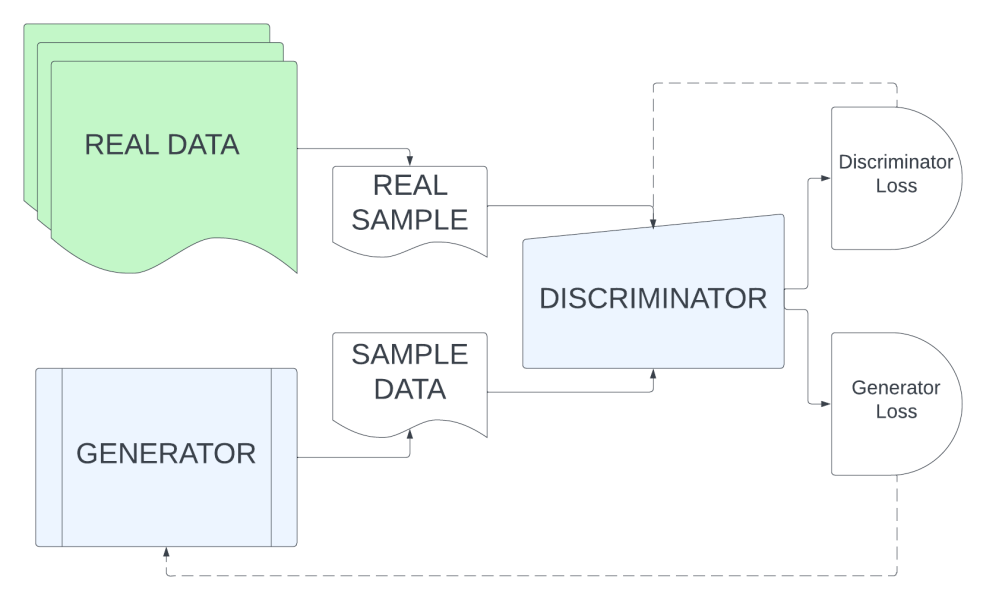
AI Atlas #14:
Generative Adversarial Networks (GANs)
Rudina Seseri
🗺️ What are Generative Adversarial Networks?
A Generative Adversarial Network (GAN) is a deep learning architecture in which two neural networks, a generator and a discriminator, compete against each other in a zero-sum game framework for generating synthetic data. The concept was initially developed by Ian Goodfellow and his colleagues in 2014 and remains highly relevant and valuable today.
The generator is a neural network that takes random noise or signal as input and generates synthetic data. For example, in the case of image generation, the generator might produce images that resemble real photographs. Initially, the generator’s outputs may not resemble the desired data closely, but it learns to improve over time through training.
The discriminator is another neural network that acts as a binary classifier, meaning it categorizes something into one of two classes or categories, in this case, real data or not. It takes as input both real data samples and synthetic data samples from the generator and attempts to classify them as real or synthetic. The discriminator is trained to accurately distinguish between the two types of data.
The generator and discriminator are then trained in a competitive manner. The generator tries to create synthetic data that can fool the discriminator into classifying the synthetic output as real. The discriminator becomes better and better at identifying real v. synthetic data. This creates a feedback loop, as the generator produces more realistic synthetic data, the discriminator also becomes more discerning and accurate in classifying real and synthetic data.
Through this feedback loop, GANs improve the generator’s ability to produce synthetic data that closely resembles real data. The training continues until the generator generates synthetic samples that are difficult for the discriminator to differentiate from real.
🤔 Why GANs Matter and Their Shortcomings
GANs have numerous significant implications including:
Realistic Data Generation: GANs excel at generating realistic and high-quality synthetic data including images, videos, and text across domains. This synthetic data can then be used to train other models.
Creative Applications: Artists, designers, and creative professionals can leverage GANs to generate unique artwork, create realistic avatars or characters, and explore new realms of creative expression
Uncovering Data Distribution: GANs can help understand and model complex data distributions by learning the underlying patterns and structures of the data
Advancing AI Research: GANs have been instrumental in advancing the field of AI research leading to breakthroughs in image synthesis, text generation, and other areas
As with all breakthroughs in artificial intelligence, there are limitations to GANs, including:
Mode Collapse: During training, the generator can fail to explore the entire range of possible outputs leading to repetitive or similar outputs and reducing the diversity of generated data.
Training Instability: Finding the right balance in the competition between the generator and discriminator is crucial and if one model becomes more dominant or weak, the performance of the GAN will be weak.
Ineffective Evaluation Metrics: Common model evaluation metrics may not capture all aspects of the data quality or diversity, leading to incomplete assessments of GANs performance.
High Data Requirements: GANs require a large and diverse dataset for training to capture the complexity of the data distribution accurately. Limited or biased training data can result in suboptimal performance and reduced generalization capability.
Resource Intensive Training: GANs are computationally intensive as a result of their architecture and the need for many training integrations and are thus costly to develop and utilize.
🛠 Uses of GANs
GANs are highly versatile and have numerous use cases including:
Manufacturing: GANs can be used in manufacturing for quality control, defect detection, and virtual prototyping by generating synthetic data to simulate different manufacturing processes, identify anomalies, and optimize production line efficiency
Finance: GANs can be leveraged to assist in financial risk assessment, fraud detection, and algorithmic trading by generating synthetic financial data for backtesting investment strategies, simulating market scenarios, and detecting anomalies or fraudulent transactions
Gaming and Entertainment: GANs can produce realistic game environments, characters, and animations such as creating lifelike virtual worlds, generating non-player characters with dynamic behaviors, and enhancing visual effects and graphics in video games
Pharmaceuticals: GANs can generate molecular structures for new potential drugs, speeding up the initial stages of drug discovery and reducing cost.
Data Augmentation for Model Training: GANs can generate synthetic data for training machine learning models, especially useful when real-world data is scarce, expensive, or confidential, to improve model accuracy and robustness.
GANs are expected to produce increasingly realistic and high-quality outputs, paving the way for broader applications across various domains as the technology meets industry requirements. GANs’ ability to generate synthetic data similar to real-world data raises concerns about privacy and consent, and thus technological advancements must be made alongside progress in interpretability and regulation.